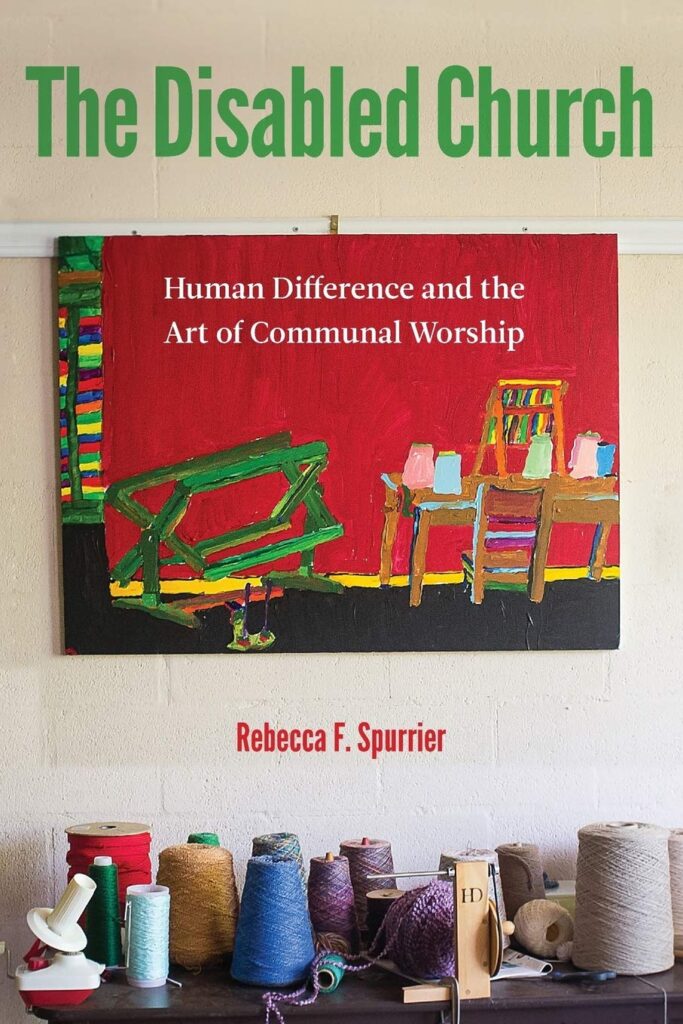Download PDF: RV Washington, The Disabled Church
By: Rebecca Spurrier
New York: Fordham Press, 2019. 272 pages. $30.00
In The Disabled Church: Human Difference and the Art of Communal Worship, liturgical theologian Rebecca Spurrier aims to bring the fields of liturgical and disability studies into conversation with one another through an exploration of a church community that “assumes difference at its heart”(2). Using data gathered over three years of ethnographic fieldwork, Spurrier paints a soulful portrait of Sacred Family, an Episcopal church in Atlanta, Georgia which has shaped its identity around the inclusion of people who live at the intersection of poverty and mental disability. Sacred Family’s week-long liturgy includes both Sunday-morning worship and the weekday activities of the Circle, a program whose participants live in personal care homes scattered throughout the Atlanta metropolitan area and who are driven to and from Sacred Family in church vans. Spurrier suggests that Christian liturgy must constitute a “response to an encounter with the creative beauty of divine love, which makes possible belonging to a
community through and across difference”(3). Spurrier adopts an aesthetic analytic frame to help identify areas of beauty which help theologians appraise and develop liturgies that do not “assume a normative set of abilities or body-minds” (197). Beauty matters, Spurrier argues because it “animates connection through desire and respect rather than pity or charity” (202) and testifies to a God who creates and draws difference together in community through “consensual, nonviolent relationships” (3).
The Disabled Church is structured by the metaphors that Spurrier develops for the liturgical activities which cultivate an intentional community of difference: gathering, weaving, disrupting, naming, and sending. One chapter is devoted to each respective metaphor. In chapter one, Spurrier maps the ecclesial topography of Sacred Family, describing the gathering spaces in and around the church – like the sanctuary, smoking area, parking lot, and garden – which contain and enable the church’s week-long liturgy. These spaces create opportunities for alternative forms of liturgical participation, which highlight and challenge the notion of worship as an able-minded activity. Further, these spaces enable the creation of “social flesh,” the development of relationships in which “people assume responsibility for one another in ways that are not divisive or condescending but that deepen understandings of mutual reliance and the need to share limited resources” (59).
Throughout chapter two, Spurrier employs the metaphor of weaving to describe the embodied and communal ways in which Sacred Family is held together. She identifies the relational liturgical art forms of touch and gesture, jokes and laughter, and silence and imagination as ways to create community while making space for difference. These acts help decenter ableist means of liturgical participation, such as reading written prayers or hymns, to hold a community of difference together across the “persistent hierarchies and divisions – without ignoring the differing abilities, statuses, and resources of members”(67). Indeed, weaving “entails and assumes both ability and inability, both agency and passivity, confusing these categories without dissolving them” (69). Spurrier thus invites the reader to rethink liturgy and reframe it not just as an opportunity to articulate a set of ideas about God, but to engender beautiful relationships with God and one another through artistries of interpersonal connection.
Chapter three considers the textures of time and pleasure in liturgical practices. Spurrier challenges the distinction between pleasure and work in the church and reconsiders the role of pleasure in liturgical spaces. What kinds of transformative relationships could we cultivate, she asks, if we thought of communal pleasure as the work of the church? Spurrier suggests that in a community of difference, like Sacred Family, the centering pleasure is not a selfish or inward-focused turn. It is instead a “turn to life with others” (128).
In chapter four, Spurrier examines how mental illness is and is not named at Sacred Family, and what effects naming has on the potential to develop authentic friendships across race, class, and ability. She explores Sacred Family’s rituals of healing and what they reveal about the church’s conceptualizations of health and wellness. Spurrier further describes the challenge of establishing relationships of equality and mutuality amidst unequal power dynamics, and how that challenge impacts the ability to restore dignity to the lives of those who experience mental health challenges. Regarding Sacred Family’s approach to the healing of mental health challenges, Spurrier notes that the church adopts a recovery framework. Thus, instead of a focus on cure, the church prioritizes “transformation in lives and relationships as [Circle participants] learn to name and live with a mental health diagnosis” (137).
In its clear-eyed willingness to engage the limits of communities of belonging created within degrading societal structures, chapter five is one of the book’s strongest. Spurrier suggests that the role of the church is to share the beauty of their carefully cultivated communities of belonging with the world and to insist that those who have been degraded and abandoned by society do indeed deserve to live with dignity. Yet, the author makes clear that Sacred Family is not a panacea. The problems many of its community members experience at the intersection of race, class, and disability persist outside the boundaries of the church, which serves as a mere refuge from social and economic marginalization and the routines and restrictions of personal care homes.
The Disabled Church closes with a challenge for church communities to find ways to uncover the beauty created in and around church grounds and disseminate that beauty into the world. Spurrier ends by posing the question of whether the creative disregard for class, race, and ability embodied in the week-long liturgy at Sacred Family contributes to a similar transformation of such boundaries in the larger society. Spurrier notes in the preface that while she approached Sacred Family with questions about the relationship between Christian liturgy and disability, she left with equally challenging concerns about the power of Christian worship to counteract “the social violence of urban spaces and the lack of safe and affordable [housing]” (xiii). To these questions, The Disabled Church leaves the reader with no easy answers. Similarly, the book raises unresolved and unanswered questions about larger structural challenges such as residential segregation and the lack of affordable housing within gentrifying cities. The reader is left with an appreciation for how Sacred Family cultivates belonging within the church community and in the social networks of its members. Yet questions remain regarding the significance of such a community to change the structure of society at a macro level. Ultimately, the book argues that ecclesial communities which consent to be transformed by difference must also commit to transforming the society which makes difference such a significant contributor to the marginalization of vulnerable persons.
The Disabled Church is at once a superbly written ethnography, a meticulous application of aesthetic theory to etic and emic liturgy, and an acknowledgment of the limits of the local church to impact societal structures which commit violence against marginalized populations. Employing ethnographic methods in an inductive approach to developing theological norms grants Spurrier the freedom to simultaneously hold multiple truths in dialectical tension. She demonstrates that while it is not entirely possible to avoid segregationist charity in communities of belonging formed across differences of race, class, and ability, there is beauty and theological significance in the attempt. Spurrier dedicates ample space to the voices and actions of Circle participants, lending valuable insight into the ways they play an active, agentive role in shaping the liturgy and culture of their church. The book is enhanced by the inclusion of photographs of Sacred Family’s gathering spaces and activities, which ground the reader in the idea that this is a real space where real belonging is engendered. Furthermore, Spurrier’s accessible prose, humility, and reflexivity provide a model of excellence for scholars and ecclesial leaders alike. Through its centering of marginalized and overlooked persons, analytic rigor, and thoughtful execution, The Disabled Church offers to the academy and the church “the fragile hope for a capacious and beautiful liturgy that assumes and desires mental differences” (213).




